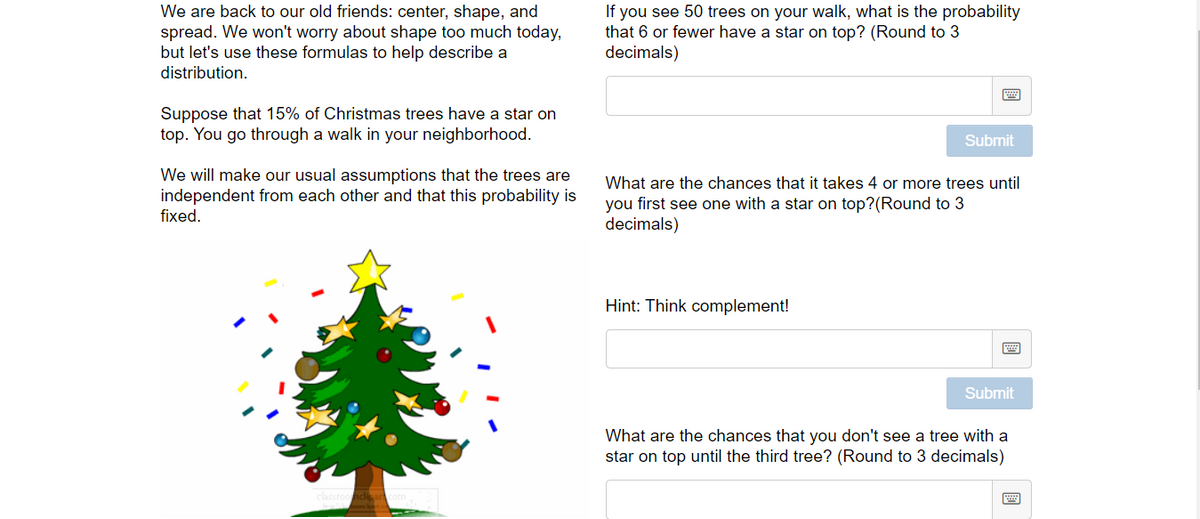We are back to our old friends: center, shape, and spread. We won't worry about shape too much today, but let's use these formulas to help describe a distribution. If you see 50 trees on your walk, what is the probability that 6 or fewer have a star on top? (Round to 3 decimals) Suppose that 15% of Christmas trees have a star on top. You go through a walk in your neighborhood. Submit We will make our usual assumptions that the trees are independent from each other and that this probability is fixed. What are the chances that it takes 4 or more trees until you first see one with a star on top?(Round to 3 decimals) Hint: Think complement! Submit What are the chances that you don't see a tree with a star on top until the third tree? (Round to 3 decimals)
We are back to our old friends: center, shape, and spread. We won't worry about shape too much today, but let's use these formulas to help describe a distribution. If you see 50 trees on your walk, what is the probability that 6 or fewer have a star on top? (Round to 3 decimals) Suppose that 15% of Christmas trees have a star on top. You go through a walk in your neighborhood. Submit We will make our usual assumptions that the trees are independent from each other and that this probability is fixed. What are the chances that it takes 4 or more trees until you first see one with a star on top?(Round to 3 decimals) Hint: Think complement! Submit What are the chances that you don't see a tree with a star on top until the third tree? (Round to 3 decimals)
College Algebra
7th Edition
ISBN:9781305115545
Author:James Stewart, Lothar Redlin, Saleem Watson
Publisher:James Stewart, Lothar Redlin, Saleem Watson
Chapter9: Counting And Probability
Section9.3: Binomial Probability
Problem 2E: If a binomial experiment has probability p success, then the probability of failure is...
Related questions
Question

Transcribed Image Text:We are back to our old friends: center, shape, and
spread. We won't worry about shape too much today,
but let's use these formulas to help describe a
distribution.
If you see 50 trees on your walk, what is the probability
that 6 or fewer have a star on top? (Round to 3
decimals)
Suppose that 15% of Christmas trees have a star on
top. You go through a walk in your neighborhood.
Submit
We will make our usual assumptions that the trees are
independent from each other and that this probability is
fixed.
What are the chances that it takes 4 or more trees until
you first see one with a star on top?(Round to 3
decimals)
Hint: Think complement!
Submit
What are the chances that you don't see a tree with a
star on top until the third tree? (Round to 3 decimals)
Expert Solution
This question has been solved!
Explore an expertly crafted, step-by-step solution for a thorough understanding of key concepts.
Step by step
Solved in 4 steps

Recommended textbooks for you

College Algebra
Algebra
ISBN:
9781305115545
Author:
James Stewart, Lothar Redlin, Saleem Watson
Publisher:
Cengage Learning

Algebra & Trigonometry with Analytic Geometry
Algebra
ISBN:
9781133382119
Author:
Swokowski
Publisher:
Cengage


College Algebra
Algebra
ISBN:
9781305115545
Author:
James Stewart, Lothar Redlin, Saleem Watson
Publisher:
Cengage Learning

Algebra & Trigonometry with Analytic Geometry
Algebra
ISBN:
9781133382119
Author:
Swokowski
Publisher:
Cengage

